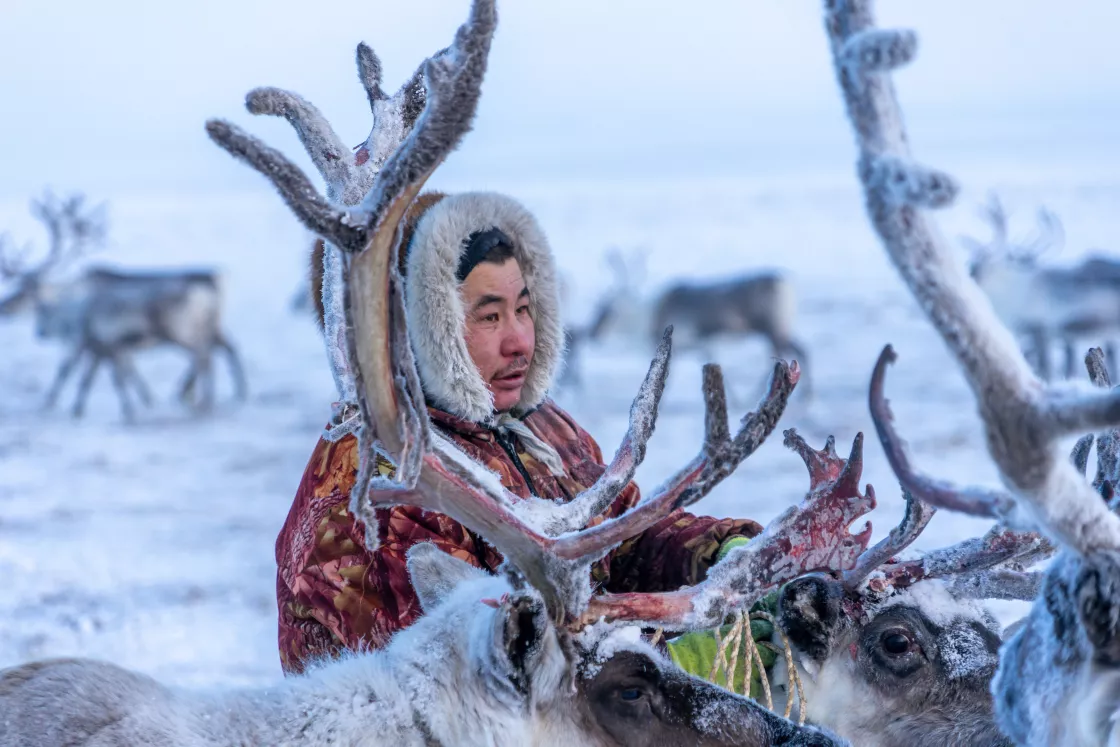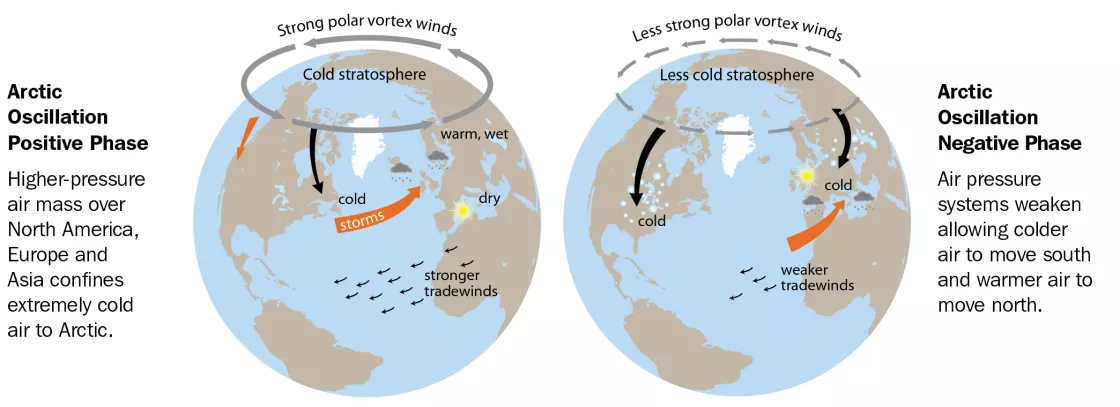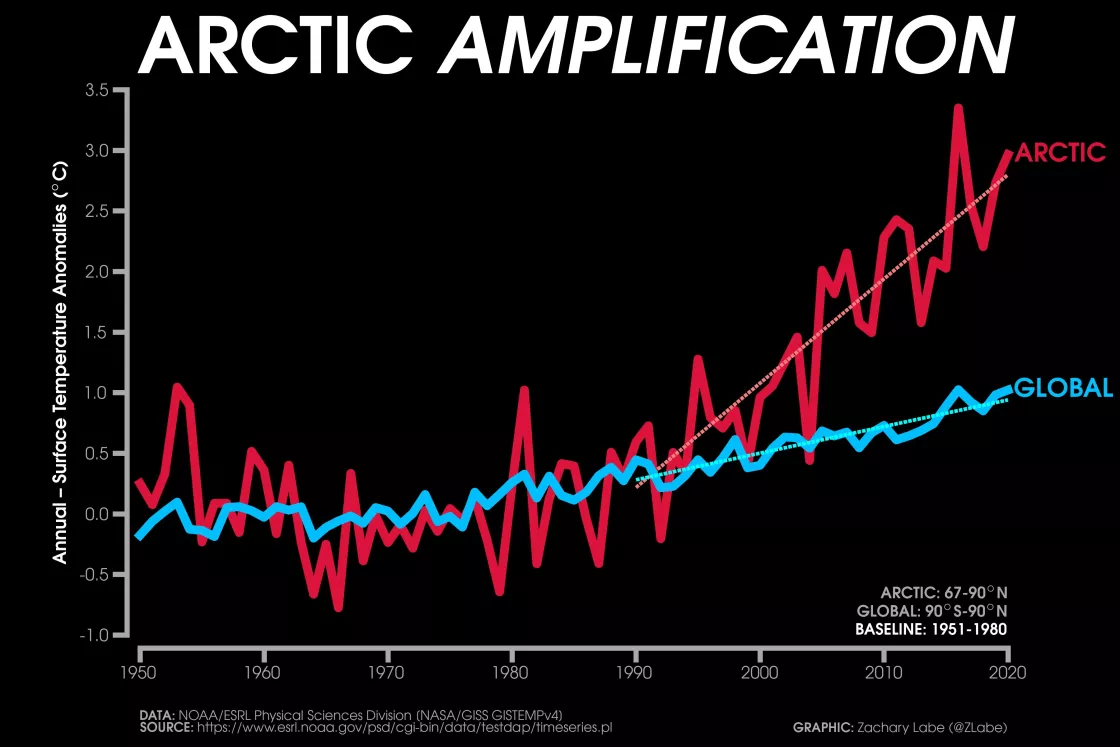Arctic Weather and Climate
Quick Facts
What is the difference between climate and weather?
Weather is the day-to-day state of the atmosphere, and its short-term variations over minutes to weeks. Climate is the weather of a place averaged over a period of time, often 30 years. Climate information includes the statistical weather information that tells us about the typical weather, as well as the range of weather extremes for a location. We talk about climate change in terms of years, decades, centuries, even millions of years.
In the Arctic, the usual meteorological conditions factor into the region’s weather: wind, humidity, temperature, cloud cover, precipitation, air pressure, and more. But the Arctic’s unique geography and high latitude also foster longer-term weather patterns, which recur regularly, even yearly.
Why is there more focus on Arctic than Antarctic climate?
There is a great deal of research on Antarctic climate and the condition of the Antarctic Ice Sheet. The reason why there is a greater focus on the climate of the Arctic is in large part because the Arctic changes have been so far more pronounced. The Antarctic is a high, cold ice sheet surrounded by ocean, while the Arctic is an ocean surrounded by land. Because of its geography, the Arctic is inherently warmer than the Antarctic. Only a small rise in temperature in the Arctic can lead to a large changes in the melting of snow and ice, initiating climate feedbacks to amplify the warming. The same amount of warming in the Antarctic will have a smaller effect.
What is the Arctic Oscillation and why does it matter?
One major pattern that scientists are always tracking is the Arctic Oscillation. The Arctic Oscillation refers to an opposing pattern of pressure between the Arctic and the northern middle latitudes. Overall, if the atmospheric pressure is high in the Arctic, it tends to be low in the northern middle latitudes, such as northern Europe and North America. If atmospheric pressure is low in the middle latitudes it is often high in the Arctic. When pressure is high in the Arctic and low in mid-latitudes, the Arctic Oscillation is in its negative phase. In the positive phase, the pattern is reversed.
Different phases of this oscillation carry consequences across the Northern Hemisphere, either causing warm and dry winters or blasting unusually cold and wet weather across Europe, China, and parts of the United States.
Are global temperatures rising?
Yes, global temperatures are rising. And the Arctic is warming at two times and in some places three times the global average, depending on the region and season. For most recent information on Arctic temperatures and the effects of climate change for that region, visit the National Oceanic and Atmospheric Administration (NOAA) Arctic Report Card.
The 2018 Intergovernmental Panel on Climate Change (IPCC) report stated that global average temperatures increased 1.0°C (1.8°F) above pre-industrial levels. The 2021 IPCC report stated that the world is likely to reach or exceed 1.5°C (2.7°F) of warming by 2040, if not sooner. Depending on the degree of emissions, the world could warm by 4.4°C (7.9°F) by 2100 with catastrophic results. Temperature records supporting IPCC findings have been assembled from thousands of land and ocean observation sites covering a large, representative portion of the Earth's surface, and carefully controlled for possible biases arising from station and instrument changes.
In January 2023, NOAA reported that 2022 had been the sixth-warmest year on record, and that the 10 warmest years on record had all occurred since 2010. The year 2023 was the warmest on record. For the most current information regarding global temperatures, please visit the NASA Goddard Institute for Space Sciences (GISS) surface temperature data.
Oceans dominate the planet's surface, and a comparison of multiple sea surface temperature records shows rising sea surface temperatures. As ocean temperatures increase, the space between molecules expands. This process known as thermal expansion is also driving ocean levels higher, and may be responsible for as much as a third of sea level rise. The other two-thirds come from alpine glacial melt and ice sheet melt (primarily Greenland), split evenly. Learn more about how glaciers and ice sheets contribute to sea level rise.
Why are global temperatures rising?
In its fourth assessment report, the IPCC cited atmospheric concentrations of greenhouse gases as the causative agent in warming temperatures. The panel identified fossil fuel burning and changes in land use as the primary causes of increased carbon dioxide, and agriculture as the primary cause of increased methane and nitrous oxide. Atmospheric carbon dioxide concentrations in 2005 exceeded the natural range for this gas over the past 650,000 years. Subsequent IPCC documents paint an even more disturbing picture. In 2021, the IPCC stated in its Summary for Policymakers, “It is unequivocal that human influence has warmed the atmosphere, ocean and land. Widespread and rapid changes in the atmosphere, ocean, cryosphere and biosphere have occurred.”
Why are temperatures increasing faster in the Arctic than the rest of the planet?
This phenomenon known as Arctic Amplification refers to the fact that the Arctic is warming at twice the rate as the rest of the world. In some parts of the Arctic, the warming is three times that of the rest of the world, depending on the season and region. As the Arctic loses more sea ice coverage, it loses its bright, reflective surface and opens up the darker ocean. This darker surface absorbs more solar energy, amplifying the warming trend. Losing Arctic sea ice clogs up Earth’s air conditioning capabilities. More heat is absorbed and less is reflected back into space.
What causes the aurora borealis?
Also called the northern lights, the spectacular color displays of the aurora borealis appear in the sky on clear, dark nights, particularly during periods when solar storms are active. The aurora borealis is centered around the geomagnetic North Pole and is most often seen near or above the Arctic Circle. However, displays occasionally appear as far south as the northern United States. The same phenomenon occurs in the Southern Hemisphere, known there as the aurora australis or southern lights.
Auroras gleam like rainbows or hang like curtains, sometimes seeming to almost touch the ground. But the actual light is produced high in the sky, 70 to 200 kilometers (43 to 124 miles) above Earth's surface—far higher than an airplane flies. The amazing color displays and formations are produced by the solar wind, a stream of electrons and protons coming from the sun. The high-energy solar wind collides with oxygen and nitrogen atoms in the upper atmosphere, exciting the gases so that they give off light. Different colors of light result from different gases at different altitudes. Auroras most commonly appear in green, although red, yellow, and blue auroras occasionally appear.




